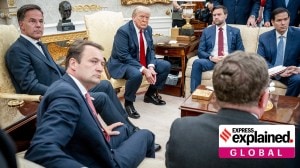Stay updated with the latest - Click here to follow us on Instagram
From Korea to Iran: A history of US conflicts — overt and covert — since World War II
In the 80 years since World War II, the United States has seldom been without a military footprint on foreign soil.
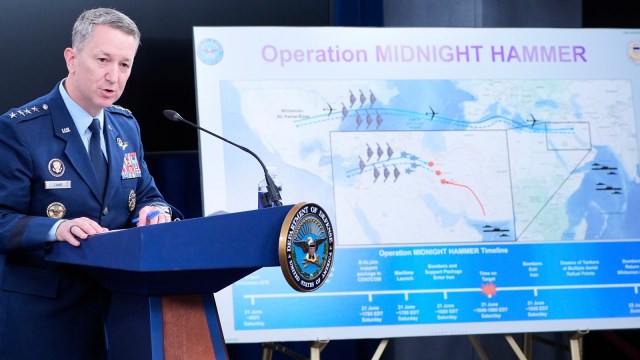 Joint Chiefs Chairman Gen Dan Caine speaks during a news conference at the Pentagon in Washington. (AP Photo/Alex Brandon)
Joint Chiefs Chairman Gen Dan Caine speaks during a news conference at the Pentagon in Washington. (AP Photo/Alex Brandon)The Second World War ended in 1945 after the United States dropped two atomic bombs on Hiroshima and Nagasaki, killing an estimated 2,00,000 people. The bombings led to Japan’s unconditional surrender on August 14, marking the end of World War II. US soldiers finally returned home to cheers, parades, and promises of peace. Yet in the 80 years since, the United States has seldom been without a military footprint on foreign soil. While the US Congress has declared war only 11 times, American forces have continuously been engaged in conflicts around the globe.
I. Containing communism
After World War II, the United States set itself as a bulwark against the spread of communism and entered several conflicts to contain Soviet and Chinese influence.
1. Korea, 1950-1953
By mid-1945, the Korean Peninsula had become a Cold War flashpoint. The Soviet Union supported the northern half, and the United States backed the southern half. On June 25, 1950, North Korean People’s Army troops crossed the 38th parallel southward, intent on unifying the peninsula under communist rule. President Harry S Truman, wary of Soviet expansionism, invoked a United Nations Security Council mandate for what he termed a “police action.” Over 15 nations joined the United States under the United Nations banner, leading to a three-year conflict known as the Korean War. By the time the fighting ceased with an armistice in July 1953, nearly 5 million people were killed, as per the American Legion, a US veterans organisation. “More than half of the casualties were civilians, about 10 per cent of the population. This rate of casualties was higher than World War II and the Vietnam War.”
2. Iran, 1953: Operation Ajax
In 1951, Iran’s democratically elected Prime Minister, Mohammad Mossadegh, nationalised the British-controlled Anglo-Iranian Oil Company. The UK vehemently objected, and the US feared Soviet influence might fill the vacuum in Iran’s oil-rich landscape. Under the presidency of Dwight D Eisenhower, the Central Intelligence Agency (CIA), in collaboration with the United Kingdom’s Secret Intelligence Service (commonly known as MI6), launched Operation Ajax, a covert operation aimed at deposing Prime Minister Mossadegh, installing a compliant monarch, and securing Western access to Iranian oil.
On August 19, 1953, after weeks of orchestrated propaganda, demonstrations, and clandestine bribery of clerics and officials, Prime Minister Mossadegh was forced from power and arrested. A declassified internal memo from the CIA stated: “The military coup that overthrew Mosaddeq and his National Front cabinet was carried out under CIA direction as an act of US foreign policy, conceived and approved at the highest levels of government.” The Shah, Mohammad Reza Pahlavi, was reinstated, but the long-term costs proved high. The operation planted deep seeds of anti-Americanism, which ultimately found crescendo in the Islamic Revolution of 1979.
3. Vietnam, 1955-1975
Vietnam, emerging from French colonial rule, became a Cold War epicentre. In 1954, the Geneva Conference resulted in dividing Vietnam at the 17th parallel: Ho Chi Minh’s Democratic Republic of Vietnam in the north, and the Republic of Vietnam in the south, backed by Western nations. To contain communism, the United States began sending military advisers in the mid-1950s. However, following the Gulf of Tonkin naval incident in August 1964, when the destroyer USS Maddox reported being attacked by North Vietnamese boats, the United States Congress passed the Gulf of Tonkin Resolution. This allowed for full-scale military escalation under President Lyndon B Johnson.
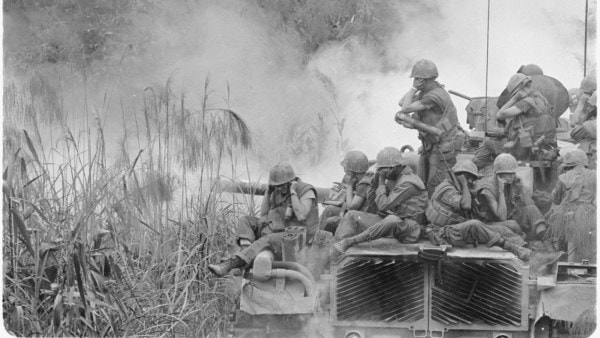 Marines on an M-48 Tank in Vietnam. (Credit: National Archives)
Marines on an M-48 Tank in Vietnam. (Credit: National Archives)
By 1969, half a million American servicemen and women were deployed (Scorched Atmospheres: The Violent Geographies of the Vietnam War and the Rise of Drone Warfare, Ian G R Shaw, 2016) amid intense jungle warfare, strategic bombing campaigns, and the deployment of chemical defoliants such as Agent Orange. The war began to unravel on the home front, as public protests surged and American casualties escalated. President Richard Milhous Nixon initiated “Vietnamisation,” withdrawing combat troops while increasing support for South Vietnamese forces. Ultimately, Saigon fell to communist forces in April 1975. The war ended with reunification under the Socialist Republic of Vietnam and cast long shadows over US foreign policy and public trust.
II. Covert wars, proxy battles, and regime change
After it intervened in Iran, the US continued to use intelligence agencies to reshape governments in Chile, Laos, Cambodia, and Africa.
4. Laos and Cambodia: America’s bombing campaigns
Between 1964 and 1973, American B-52 bombers dropped over two million tonnes of ordnance on the Kingdom of Laos, making it “per person, the most heavily bombed country in history.” (Remarks of President Obama to the People of Laos, 2016). The bombing campaign was conducted under the codename Operation Barrel Roll (later supplemented by Operation Steel Tiger).
In the Kingdom of Cambodia, Operation Menu involved covert airstrikes aimed at destabilising communist supply routes in violation of Cambodian neutrality. The chaos these bombings engendered helped pave the way for the rise of the Khmer Rouge regime, which directly led to the Cambodian Genocide that claimed the lives of around 1.5-3 million people over four years, as per the University of Minnesota, Holocaust and Genocide Studies records.
5. Chile, September 11, 1973 coup
In South America, the Cold War paranoia extended to elected socialist democracies. Chile’s democratically elected President, Salvador Allende, who took office in November 1970, alarmed United States officials. Henry Alfred Kissinger, then National Security Advisor, regarded Allende as a threat, and President Richard Nixon feared a repeat of Cuba. Declassified CIA documents revealed secret funding of opposition media, support for labour strikes, and covert efforts to destabilise the Allende government. On September 11, 1973, General Augusto José Ramón Pinochet’s military junta bombed La Moneda Palace, resulting in President Allende’s death. A brutal dictatorship ensued, with thousands tortured and disappeared over the next 17 years.
6. Nicaragua and the Iran-Contra Affair
In Central America, after the Sandinista National Liberation Front successfully overthrew the Somoza (a political family that ruled Nicaragua for 43 years) dictatorship in 1979, the United States responded by backing the Contrarrevolucionarios, commonly known as the Contras. President Ronald Wilson Reagan’s administration directed covert assistance to the Contras, despite the passage of the Boland Amendment by the United States Congress, which banned such funding. When the operation was exposed in November 1986, it became known as the Iran–Contra scandal, which involved American covert dealings involving the sale of weapons to Iran, in exchange for funds funneled to the Contras.
7. Angola: Proxy war
In Southern Africa, Angola descended into civil war upon Portuguese decolonisation in 1975. Competing factions — the Soviet- and Cuban-backed Popular Movement for the Liberation of Angola, and the American- and South African–supported National Union for the Total Independence of Angola (UNITA) and the National Liberation Front of Angola (FNLA) — clashed in a conflict lasting until 2002. While the United States did not deploy combat forces, the CIA provided millions of dollars worth of arms and logistical support, as per a 1975 New York Times report. Jonas Savimbi’s UNITA became the primary beneficiary of US covert involvement. The war resulted in hundreds of thousands of deaths, widespread displacement, and disruption of regional stability.
8. Iran-Iraq War (1980-1988)
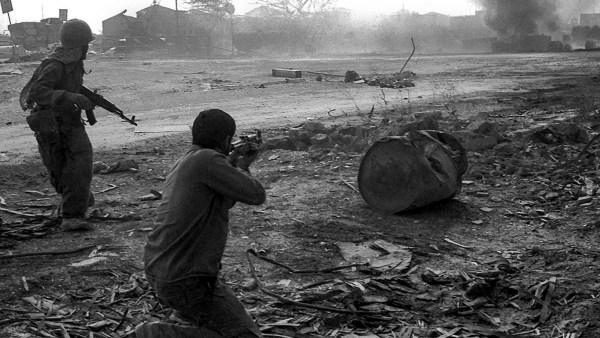 Throughout the war, the US provided intelligence, satellite imagery, and material support to Iraq. (Wikimedia Commons)
Throughout the war, the US provided intelligence, satellite imagery, and material support to Iraq. (Wikimedia Commons)
The United States maintained an official stance of neutrality during the Iran-Iraq War but in practice pursued a contradictory policy pursuant of its strategic interests in the Middle East. Initially, US policymakers saw Iraq, under Saddam Hussein, as a potential counterbalance to revolutionary Iran, especially after the 1979 US Embassy hostage crisis and the fall of the pro-American Shah.
While the US did not directly initiate the war, reports and declassified records suggest it tacitly approved Iraq’s invasion of Iran, believing it might weaken Iran’s Islamic regime. Throughout the war, the US provided intelligence, satellite imagery, and material support to Iraq. At the same time, the US covertly sold arms to Iran in what became known as the Iran-Contra Affair. This dual-track “tilt” policy aimed to prevent either side from winning, thereby preserving regional balance and securing American strategic interests, particularly oil access and Israel’s security. Ultimately, US involvement prolonged the conflict and intensified regional instability.
III. Precision strikes
With the Cold War over, the United States turned to precision warfare to assert its global dominance.
9. The Gulf War, 1990-1991
In August 1990, Iraqi President Saddam Hussein, reeling from the financial wreckage of the Iran-Iraq War and $37 billion in Gulf debts, ordered an invasion of Kuwait. Initially, sanctions were imposed after an international backlash. Under the leadership of President George HW Bush, the United States assembled a coalition of 34 nations under the United Nations Security Council resolutions to liberate Kuwait.
Operation Desert Shield transitioned to Operation Desert Storm on January 17, 1991. A six-week air campaign devastated Iraqi military infrastructure, followed by a 100-hour ground offensive in February 1991 that liberated Kuwait. However, Saddam remained in power, internal rebellions were suppressed, and economic sanctions remained in place.
IV. The global war on terror
After September 11, 2001, the US launched an open-ended war on terror, stretching from Afghanistan and Iraq to Yemen and Somalia. In a strong statement after the attack, President George W Bush said, “We’re going to meet and deliberate and discuss – but there’s no question about it, this act will not stand; we will find those who did it; we will smoke them out of their holes; we will get them running and we’ll bring them to justice. We will not only deal with those who dare attack America, we will deal with those who harbor them and feed them and house them.”
10. Afghanistan ( 2001-2021): America’s longest war
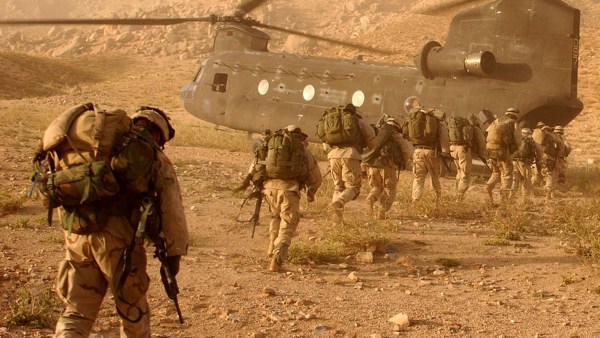 U.S. troops board a CH-47 Chinook helicopter in Zabul province on September 4, 2003. The soldiers, assigned to Company A, 2nd Battalion, 22nd Infantry Regiment, 10th Mountain Division, were returning to Kandahar Army Air Field after conducting a search in the Daychopan district for Taliban fighters and illegal weapons caches. (U.S. Army photo by Staff Sgt. Kyle Davis/Wikimedia Commons)
U.S. troops board a CH-47 Chinook helicopter in Zabul province on September 4, 2003. The soldiers, assigned to Company A, 2nd Battalion, 22nd Infantry Regiment, 10th Mountain Division, were returning to Kandahar Army Air Field after conducting a search in the Daychopan district for Taliban fighters and illegal weapons caches. (U.S. Army photo by Staff Sgt. Kyle Davis/Wikimedia Commons)
The September 11, 2001 terrorist attacks by al-Qaeda triggered an immediate American response. President Bush authorised Operation Enduring Freedom in October, targeting al-Qaeda training camps and Taliban regime infrastructure in Afghanistan. With rapid initial success, the Taliban were deposed. Over time, however, the mission shifted toward counterinsurgency, governance challenges, and infrastructure development, as directed by NATO and United States Central Command. After nearly two decades and a cost of close to two trillion dollars, the United States formally withdrew military forces in August 2021, marking the return of the Taliban.
11. Iraq (2003-2011 and 2014-2021)
In March 2003, the United States, under President George W Bush, launched Operation Iraqi Freedom, asserting that Iraqi President Saddam Hussein possessed weapons of mass destruction and harboured ties to terrorist networks. Baghdad fell swiftly, but the resulting power vacuum spawned an extended insurgency. Sectarian violence escalated, large-scale reconstruction efforts faltered, and humanitarian crises mounted amid allegations of torture and human rights abuses. No weapons of mass destruction were ever recovered, prompting global scrutiny and American skepticism. The Chilcot Report confirmed that the UK went to war in Iraq based on flawed intelligence that claimed Saddam Hussein possessed weapons of mass destruction (WMDs). In response, former Prime Minister Tony Blair offered a limited apology but defended the decision to remove Saddam Hussein. In a 2015 CNN interview ahead of the report’s release, Blair admitted: “I apologise for the fact that the intelligence we received was wrong. I also apologise for some of the mistakes in planning and, certainly, our mistake in our understanding of what would happen once you removed the regime.” The United States completed its military withdrawal in December 2011, but instability persisted. Despite its support for the withdrawal from Iraq, the Obama administration in 2014 returned American military forces to Iraq to wage war on ISIS and then extended the war into Syria.
12. Libya, 2011: Humanitarian intervention
In February 2011, the State of Libya saw widespread unrest as part of the Arab Spring, a series of pro-democracy protests, uprisings, and armed rebellions. Libyan leader Muammar Muhammad Abu Minyar al-Gaddafi responded with brutal force, prompting the United Nations Security Council to pass Resolution 1973, authorising “all necessary measures” to protect civilians. The North Atlantic Treaty Organization (NATO), with limited direct American involvement, enforced a no-fly zone and launched air strikes. Gaddafi was killed in October, but the leadership vacuum spawned competing militias and rival governments.
13. Syria, 2011-present
The Syrian Arab Republic descended into civil war in March 2011, when the Bashar Hafez al-Assad regime violently suppressed civilian protests. Over time, multiple groups entered the conflict, including the Islamic State of Iraq and Syria (ISIS), Kurdish-led Kurdish forces, the Syrian Arab Army, and intervening foreign powers, including Russia, Iran, and the United States. American involvement remained deliberately limited: both covert and overt support for moderate rebel groups, NATO-led airstrikes targeting ISIS, and paramilitary assistance to Kurdish allies via the United States Special Operations Command. As of 2025, Ahmed al-Sharaa, who led a campaign that toppled Bashar al-Assad, is President.
V. The age of remote warfare
14. Drone strikes in Pakistan, Yemen, and Somalia
In the aftermath of the September 11 attacks, the United States started using unmanned aerial vehicles (drones) to neutralise threats. President Bush authorised covert strikes against terrorist leaders in “ungoverned spaces.” Under President Barack Obama, drone use intensified, both for “targeted strikes,” aimed at identified terrorist members, and more controversial “signature strikes,” which were finally based on behavioral patterns rather than confirmed identity. Operating largely out of air bases in Pakistan and Yemen, and coordinated via the United States Africa Command in East Africa, these drone programmes allegedly killed hundreds of al-Qaeda, Taliban, and Islamic State fighters. Osama bin Laden was killed during a US military raid in Abbottabad, Pakistan, on May 2, 2011.
15. Niger and the Sahel Region
During the 2010s, the United States pivoted to Africa’s Sahel region, deploying 1,100 troops to the Republic of Niger (The Guardian, March 2024), equipping and training local militaries, operating drone surveillance and strike platforms from a newly constructed airfield near Agadez, and supporting both anti-terror operations and humanitarian missions. In July 2023, a military coup ousted democratically elected President Mohamed Bazoum and suspended existing security agreements with the United States. However, the relations between Niger and the US deteriorated after the military junta claimed power in July 2023, in what the US called a coup (CNN, March 16, 2024). Since then, the US has withdrawn many of its 1,100 troops who were stationed in Niger.
VII. The Present
Since the Iran-Iraq war, US presidents have avoided hitting Iran directly. The risks of regional war, soaring oil prices, and global instability were too high. It changed this year in June after President Donald Trump ordered direct military strikes on Iran’s nuclear facilities.
Trump called the strikes “a spectacular military success.” In a televised adress he said Iran’s key nuclear enrichment facilities had been “completely and totally obliterated.”
“If peace does not come quickly, we will go after those other targets with precision, speed and skill,” he said.
- 01
- 02
- 03
- 04
- 05












